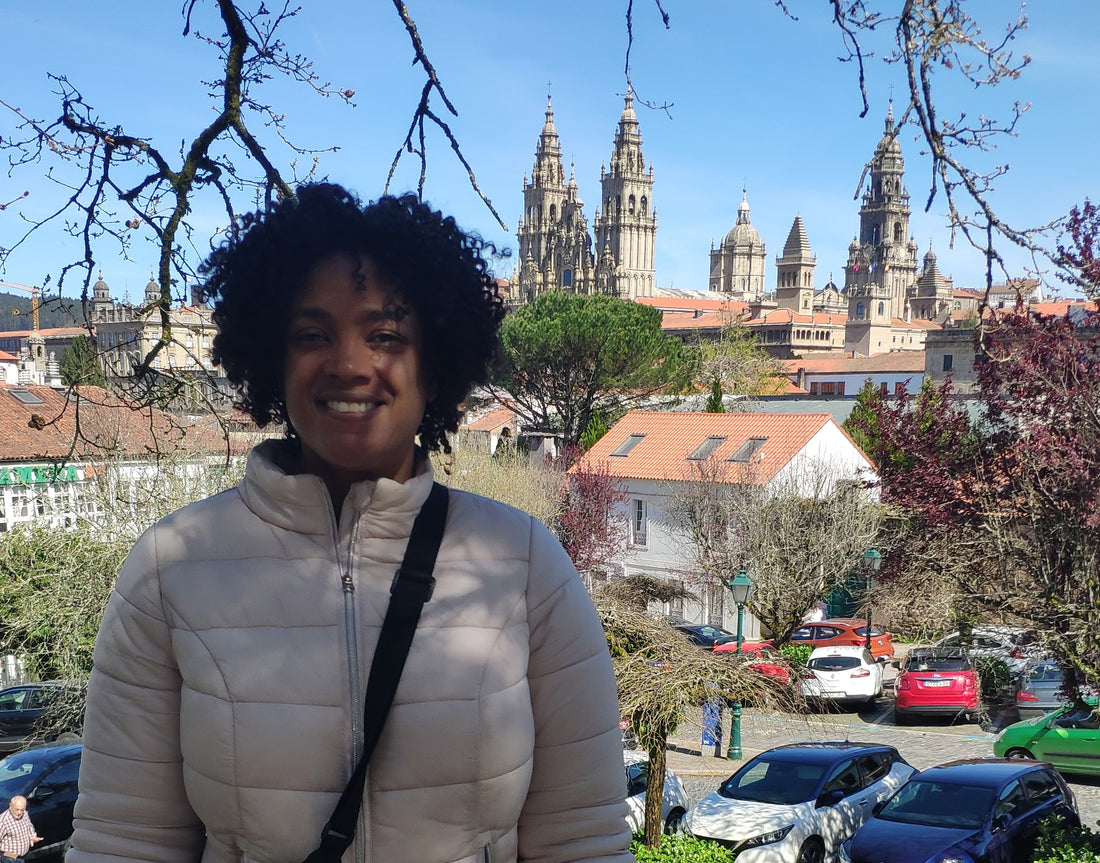Jerusalem, Rome, and...Santiago de Compostela. Each year, a half million Christians end their pilgrimage in this city located in the northwest of Spain. Santiago de Compostela has been a Christian holy site since the 9th century when the remains of Apostle St. James along with two of his disciples, Theodore and Athanasius, were discovered in a Roman burial ground located in what is now called Padron, which is 16 miles south of Santiago de Compostela. St. James is credited with spreading Christianity to the Iberian peninsula. After Christianizing Iberia, he returned to Jerusalem where he was beheaded on the orders of King Herod Agrippa I of Judaea. St. James' body was taken by boat to Galicia (region in northwest Spain where Santiago de Compostela is located) by his two disciples. In 829, on the order of King Alfonso II of Asturias, a small church was built on the current site of the Santiago Cathedral to house the body of St. James. The initial church was too small to hold all of the visitors, so a larger one was erected on the site in 899. An even larger cathedral replaced the 9th century one, which was completed in 1211 and the baroque façade was added in the 18th century.

Model of the second church, completed in 899.
No trip to Santiago de Compostela is complete without a visit to the cathedral, which, for visitors, is separated into four parts: the museum, the Portico de la Gloria/Porch of Glory, the crypt, and the church. The church houses the remains of St. James and the Romanesque Portico de la Gloria is magnificent and worth seeing. It is located at the back of the church behind a literal paywall. My tour guide said that after the restoration, a barrier was erected so that guests had to pay to see the Portico. The Portico consists of archways just inside of the old main entrance of the church and contains elaborate carved statues of holy figures in a complex iconographic array of apocalyptic and salvific content focused on the vision of Jerusalem. It was built by Master Mateo between 1168 and 1188. Unfortunately, no photos are allowed inside of the cathedral, but there are some on the cathedral's website.
The cathedral has historically been a place of pilgrimage on the Way of St. James (The Camino) since the Early Middle Ages and marks the end of the pilgrimage route. During my visit, I saw a lot of pilgrims around the cathedral. If you decide to do the pilgrimage and you are one of the first ten pilgrims to arrive at the cathedral on a given day, you will get free entry. Usually, the first pilgrims start to arrive at 10am. Also, there are other museums, such as the Santa Maria de Sar Church, that offers free entry to pilgrims. If you are not a pilgrim who plans to arrive early to the cathedral, I strongly recommend that you purchase tickets in advance either on the cathedral's website or in person to get your preferred timeslot. I took a rooftop guided tour (only available in Spanish), which is not for the faint of heart. The roof is slanted.

Santiago de Compostela Cathedral

At Alameda Park with the cathedral in the background.
Santiago de Compostela is a small, relaxed city and a far cry from the hustle and bustle of Madrid and Barcelona. I also felt very safe walking around, even at night. Per usual, I went on a "free" tip-based walking tour to see which sites I wanted to explore further. One was the Hospital Real de Santiago de Compostela, which was an old hospital turned luxury hotel. The gardens are open to the public and it used to have a leech storage bowl. Next to the hospital/luxury hotel is an active medical school. Initially, pilgrims were treated for ailments inside of the cathedral, but it got too crowded so a hospital was built between 1499 and 1511.
If you have a sweet tooth and want freshly baked sweets, look no further than the Royal Monastery of San Pelayo de Antealtares. My tour guide told us about a bakery located in a monastery and I saw that the Google reviews were excellent. There's no sign, you just have to know that it's there. Enter through the green door and you'll see a display of what they have. Ring the bell to the left of the display, and a nice nun opens the door and takes your order. Cash only. They are known to have one of the best Santiago's Cake. However, I opted to buy the cake at Mercedes Mora, which was recommended by a friend whose mom grew up in Galicia.
 Santiago's Cake
Santiago's Cake
My tour guide graduated from the Faculty of Geography and History at the University of Santiago de Compostela, and recommended a visit to its library. The library is closed to visitors except on Saturdays so that students aren't disturbed.

The library at the Faculty of Geography and History at the University of Santiago de Compostela.
Don't let the photo below scare you, like it scared me. I entered the Santa María Salomé Church and almost had a heart attack. However, those are not KKK uniforms. The robes are called capirote and have been worn since the Middle Ages to show penance in the Catholic tradition. My tour guide suggested that we visit the church, because it has statues of saints with glasses, which is different from normal. She did not mention the KKK look-a-like outfit. Spanish people are so used to this outfit, because it is a part of their Catholic culture. They can always spot the Americans in the crowd during the Catholic parades, because we look horrified when the men in capirotes pass by.

Capirote at Santa María Salomé Church.
Located in San Domingo de Bonaval convent, which dates back to the 17th-18th century, the Ethnographic Museum exhibits a very extensive collection of items of popular Galician culture. Most of the exhibits are in Galician, but there are a few on the upper floors that are in Spanish and English. Another of the museum's attractions is the spectacular triple helicoid staircase. Also, the museum is attached to a church that is the Panteón de Galegos Ilustres, in which very famous personalities from Galician culture are buried, such as Rosalía de Castro.

Triple helicoid staircase at Museo del Pueblo Gallego (Galician Ethnographic Museum).
I went on a day excursion with Toxo Travel to what the Romans called, "The end of the earth" and former terminus of the Way of St. James (The Camino). The weather was miserable, but I could tell that in the spring/summer, it's lovely.

Kilometer marker 0 on The Camino at Fisterra, Spain.
GETTING THERE AND GROUND TRANSPORTATION
Santiago de Compostela is a small city, so there are no direct flights from the U.S. Most likely, you will connect via Barcelona or Madrid. A flight from Madrid takes about one hour. If you are already in Spain, you can opt for a high speed train, which takes about three hours from Madrid non stop. I chose to fly, because tickets were cheap on Ryanair.
Getting to and from the airport is a pain. There is a bus, 6A, that runs every 30 minutes and costs €1 cash. However, it serves both locals and travelers, so it has many stops. The bus takes 50 minutes to get to and from the city. If you are in Santiago de Compostela during the high season, it isn't uncommon for the bus to speed past stops because it is full. Therefore, it is better to take a taxi during high season, which is about €25 and takes 20 minutes.
Ground transportation isn't really necessary, because the city is small and walkable. However, like other cities in northern Spain, ride sharing apps in Santiago de Compostela are blocked and you cannot hail taxis from the street. You must go to designated taxi stands or call a taxi company for a pickup...like it's 1985. Note that taxi companies charge an additional €3.20 to make a taxi reservation.
THINGS TO DO
Santiago de Compostela Cathedral
Alameda Park
Pobo Galego Museum
Museum of Pilgrimage
The library at the Faculty of Geography and History, University of Santiago de Compostela (European 2nd floor/American 3rd floor and open for visitors on Saturdays)
Temporary exhibitions at the University of Santiago de Compostela (next to the cathedral)
Hospital Real/Parador de Santiago de Compostela
Monastery of San Martiño Pinario
Abastos Market
City of Fisterra
RESTAURANTS & CAFES
Costa Vella Garden Cafe
Café Tertulia
Ratiños Coffee Shop
Asador Restaurante A Vaquiña
A Noiesa
O Sendeiro
San Pelayo Antealtares Monestary (take out bakery, cash only)
Mercedes Mora (the best Santiago's cake in the city)
Etel&pan (located in Fisterra)

